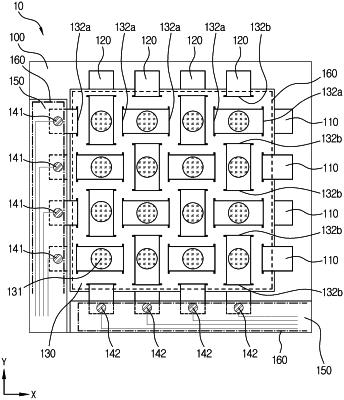| CPC G01L 1/205 (2013.01) [G06F 3/045 (2013.01); H05B 3/347 (2013.01)] | 11 Claims |

|
1. A pressure sensor using conductive thread, the pressure sensor comprising:
a plurality of first conductive lines arranged parallel to each other in a first direction in a state of being spaced apart from each other;
a plurality of second conductive lines arranged parallel to each other in a second direction intersecting the first direction in a state of being spaced apart from each other; and
a spacer located between the plurality of first conductive lines and the plurality of second conductive lines, resistance of the spacer being changed when pressure is applied thereto,
wherein the spacer comprises a plurality of resistance areas each formed in a cross area in which each of the plurality of first conductive lines and a corresponding one of the plurality of second conductive lines intersect each other, resistance of the resistance areas configured to be changed in response to a change in pressure, and
wherein:
each of the first conductive lines and the second conductive lines is fabric made of conductive thread and has a predetermined width and length,
the spacer is configured such that:
a first slit having a size corresponding to a width of a first conductive line of the plurality of first conductive lines is formed between two resistance areas neighboring each other in the first direction, among the resistance areas, and
the first conductive line is formed so as to pass through the first slit from a first surface to a second surface of the spacer and to pass through another first slit closest thereto from the second surface to the first surface of the spacer.
|